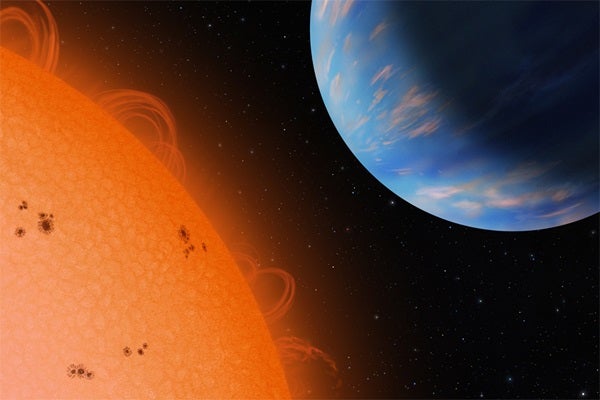On Monday morning at the American Astronomical Society meeting in Honolulu, an international team of astronomers announced the discovery and identification of 28 new extrasolar planets. This largest-ever announcement, made by post-doctoral fellow Jason T. Wright and newly minted Ph.D. John Asher Johnson, both of the University of California-Berkeley, brings the total number of planets known outside our solar system to 236. “In the last year we’ve found 37 substellar objects,” says Wright, “the 28 new planets constituting more than 10 percent of those now known.” Wright reported that 7 of the substellar objects are thought to be brown dwarfs, and that four of the newfound exoplanets lie within multiplanet systems.
The announcement, expected to be the most newsworthy event of this week’s meeting, results from the work of the California and Carnegie Planet Search Team and the Anglo-Australian Planet Search Team. “We’ve added 12 percent to the total in the last year, and we’re very proud of that,” says Wright. “This provides new planetary systems so that we can study their properties as an ensemble.”
Wright outlined three findings from the last year as important, each being underscored by this latest announcement. First, multiplanet systems are now known to be common. Second, long-period and low-mass planets are now known to be common. Third, circular orbits, like those of the planets in our solar system, are apparently rare. “We’re just now getting to the point where, if we were observing our own solar system from afar, we would be seeing Jupiter,” says Wright. “If we were in another planetary system looking back at ours, this might be the press conference in which we announced the discovery of Jupiter.”
In addition to the new planets, Wright singled out an exoplanet discovered 2 years ago as surprising and exceptionally “rich.” Orbiting the star Gliese 436, a red dwarf M star only 30 light-years away, Gliese 436b is an ice-giant planet thought to weigh at least 22 Earth-masses, slightly more massive than Neptune (which has 17 Earth-masses). After the planet’s discovery, Michael Gillon at Liege University in Belgium observed the planet as it transited its star, constituting the first-ever transit of a Neptune-sized exoplanet. “The transit allowed us to precisely pin down the planet’s mass, and to calculate the planet’s radius and density,” says Wright. “From the density of 2 grams per cubic centimeter, twice that of water,” says Geoff Marcy, the planet-search team’s founder, “it must be 50-percent rock and about 50-percent water, with perhaps small amounts of hydrogen and helium.”
Wright elaborated that Gliese 436b has a small, rocky core surrounded by a thick envelope of water that is highly pressurized into a solid-like form, and an outer envelope of hydrogen and helium gas. Gliese 436b has a 2.6-day orbit, making it very close to its host star, and an eccentric orbit, making it a “hot Neptune.”
Three of the new planets orbit large stars with masses between 1.6 and 1.9 that of the Sun. Johnson reported on his work seeking out exoplanets around massive, type A and F stars. These planets are normally very hard to detect, as they rotate quickly and have pulsating atmospheres, which could hide them from detection. However, Johnson reported on targeting cooler, so-called retired A stars, subgiants that have nearly finished burning hydrogen and have stabilized for a short period. These candidates are “quiet” enough to make planetary wobbles visible.
Johnson has thus far found six exoplanets around retired A stars — and three of the newly discovered planets orbit these stars — affording the chance for some preliminary conclusions. Planets orbiting massive stars seem to lie at greater orbital distances than planets around less massive stars, for example. “Only one of the nine planets is within one AU, and none of them is within 0.8 AU of their host stars,” says Johnson, “which is very different from the distribution among Sun-like stars.” (One AU, or astronomical unit, is the average Earth-Sun distance.)
Johnson characterizes massive stars as more likely to host a Jupiter-sized planet. He’ll continue to monitor massive stars for exoplanets and, as more discoveries are made, will gain a clearer picture about how planetary systems surrounding massive stars differ from those around stars like the Sun.
In the same press conference, Edward F. Guinan of Villanova University described his research on planetary systems orbiting red, or M, dwarf stars. Guinan reported that, contrary to previous ideas, M dwarf stars could, in theory, be suitable, stable places for planetary systems that could harbor life. “At one time M stars were thought to be bad news for planets,” he says. “Not anymore.” In his paper, “Living with a red dwarf,” Guinan reported that stable planetary orbits within the so-called habitable zone, the region in which liquid water could exist, are quite possible with M dwarf stars. These stars have low masses of 1/10 to ½ that of the Sun. The planets within the habitable zone would be orbiting close in, only 0.1 to 0.2 AU. This would make living things on such planets susceptible to dangerous flares from their host stars, which could wipe out life on the planets. However, magnetic fields could protect the planets, Guinan reported. Therefore, “Planets around M dwarf stars can theoretically support life,” he says.










